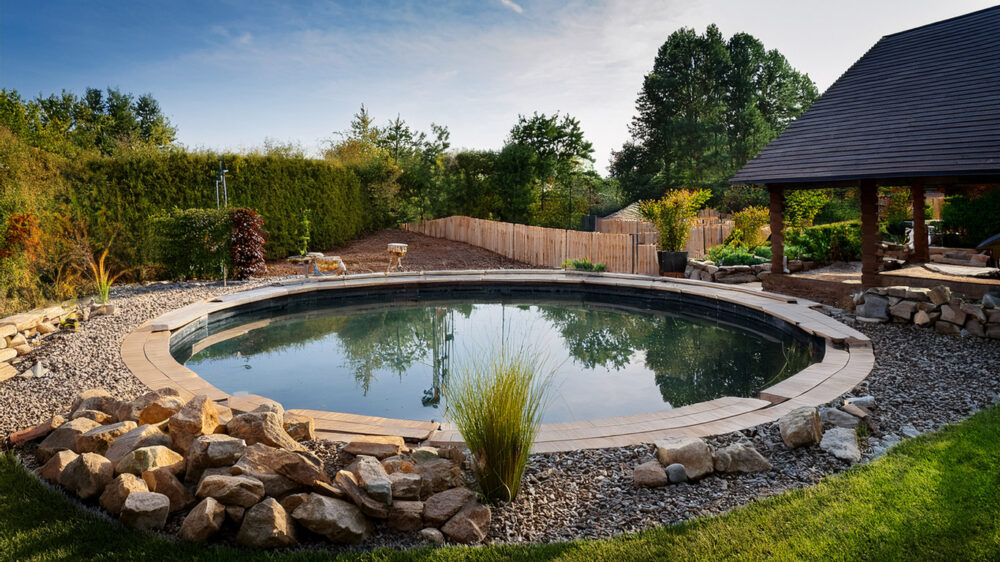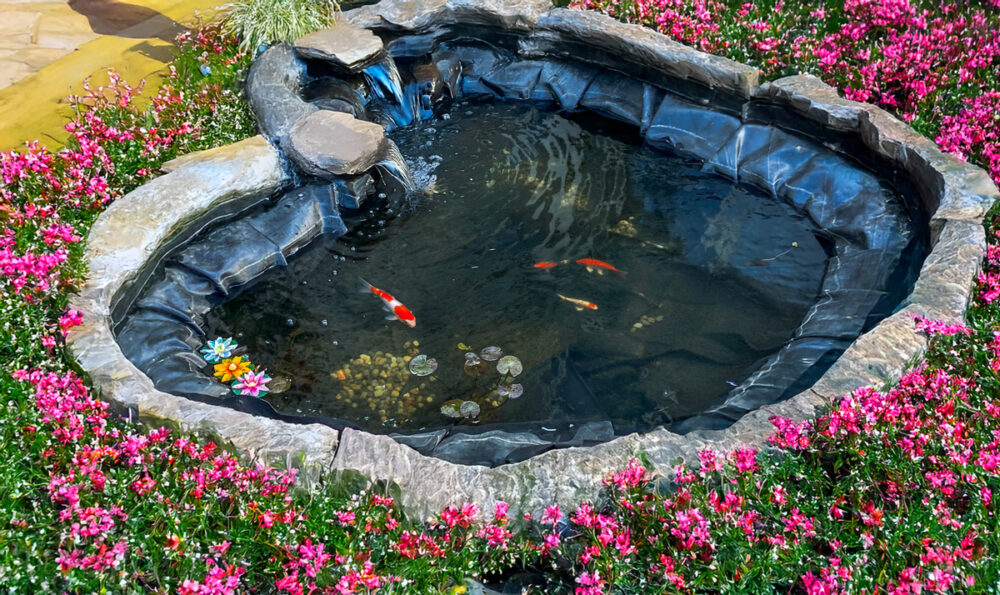Building a koi pond is an exciting project, but one of the most crucial decisions you’ll make is choosing the right pond liner. A good liner ensures your pond remains leak-free, supports a healthy ecosystem, and stands up to weather changes. With so many options available, it can be overwhelming to find the best one for your specific needs.
In this guide, we’ll break down the most popular pond liners, their advantages and disadvantages, and what makes them suitable for koi ponds. Whether you’re looking for an affordable, flexible, or heavy-duty liner, this guide will help you make an informed decision.
Best Pond Liner Recommendations
Choosing the right pond liner is essential for creating a long-lasting, leak-proof koi pond. Below, we review some of the best options available, breaking down their features, pros, and why they stand out.
1. Firestone Pond Liner – Best Overall Choice
Firestone is a well-known name in pond liners, and their EPDM rubber liner is one of the best options for koi ponds. It’s highly durable, flexible, and resistant to UV rays, making it perfect for long-term use.
Why We Love It:
- High-quality EPDM rubber ensures durability
- UV and weather-resistant for long-term outdoor use
- Highly flexible, making it great for custom pond shapes
- Safe for fish and plants with no toxic chemicals
- Excellent puncture resistance to prevent leaks
Potential Downsides:
- Heavier than PVC liners, making installation slightly harder
- Requires an underlayment for best results
Best For: Those looking for a high-quality, long-lasting liner for medium to large koi ponds.
2. Aquascape PRO Grade Pond Liner – Best for Professional Builds
Aquascape’s PRO Grade 45-mil EPDM liner is designed for serious koi pond owners who want a high-quality, professional-grade liner that will last for decades. It’s extremely flexible, making it ideal for ponds with curves and waterfalls.
Why We Love It:
- Thick 45-mil EPDM rubber provides superior durability
- Highly flexible, making installation easy for custom designs
- Resistant to UV damage, extreme weather, and punctures
- Backed by a long warranty for peace of mind
- Safe for fish and aquatic plants
Potential Downsides:
- More expensive than standard liners
- Heavy material can make handling difficult during installation
Best For: Those looking for a professional-quality pond liner that will last for decades without issues.
3. LifeGuard 45 Mil EPDM Pond Liner – Best Heavy-Duty Choice
LifeGuard’s 45-mil EPDM pond liner is one of the most durable options available. It’s tear-resistant, flexible, and built to last for decades, making it a great choice for large koi ponds or ponds with complex designs.
Why We Love It:
- Premium 45-mil EPDM rubber for extreme durability
- Highly flexible, allowing for easy installation in irregular pond shapes
- Puncture-resistant and designed to withstand rough terrain
- UV and weather-resistant, ensuring long-lasting performance
- Safe for koi and other aquatic life
Potential Downsides:
- Heavier than PVC liners, making it harder to handle during setup
- Requires an underlayment for maximum longevity
- More expensive upfront, but lasts longer
Best For: Large koi ponds or pond owners looking for an extra-durable, long-lasting liner.
4. TotalPond Pond Liner – Best Budget Option
TotalPond’s PVC pond liner is an affordable and beginner-friendly option for smaller koi ponds. It’s lightweight, easy to install, and a great entry-level choice, though it may not be as durable as EPDM or RPE liners.
Why We Love It:
- Very affordable, making it great for budget-conscious buyers
- Lightweight and easy to install, even for beginners
- Flexible enough to fit small to medium ponds
- Safe for fish and plants when used correctly
Potential Downsides:
- Not as durable as EPDM or RPE—more prone to punctures
- Shorter lifespan (10-15 years) compared to higher-end liners
Best For: Small koi ponds or those looking for a budget-friendly liner for a temporary setup.
5. UWIOFF 20 Mil Pond Liner – Best for Small & Medium Ponds
The UWIOFF 20 Mil pond liner is a PVC liner that’s thicker than standard budget options while still being flexible and easy to work with. It’s a great mid-range option for small to medium koi ponds.
Why We Love It:
- 20 Mil thickness offers better durability than standard PVC liners
- Flexible and lightweight, making installation easy
- UV and puncture-resistant for longer-lasting performance
- Safe for koi and plants
Potential Downsides:
- Not as thick or long-lasting as EPDM or RPE liners
- Requires extra care when installing to avoid punctures
Best For: Those looking for a mid-range liner that’s stronger than standard PVC but more affordable than EPDM.
Why a Good Pond Liner Matters
A high-quality pond liner is the foundation of your koi pond. It prevents leaks, protects the pond from external contaminants, and ensures a stable environment for your koi. The best liners should be:
- Durable and puncture-resistant to withstand sharp rocks and debris
- Flexible to fit any pond shape
- UV and weather-resistant for long-lasting performance
- Safe for fish and plants with no harmful chemicals
- Easy to install and maintain

Now, let’s look at the different types of pond liners and which ones are best for koi ponds.
Types of Pond Liners
EPDM Rubber Pond Liners (Best Overall Choice)
EPDM (Ethylene Propylene Diene Monomer) rubber liners are among the most popular choices for koi ponds due to their exceptional durability and flexibility. They are ideal for custom-shaped ponds and can last for decades with proper care.
Pros:
- Highly flexible—easily adapts to any pond shape
- Extremely durable and resistant to punctures
- Long lifespan (20+ years)
- UV-resistant and completely safe for koi fish
- Eco-friendly and non-toxic
Cons:
- Heavier than other liner materials
- More expensive than PVC liners
- Requires underlayment to prevent punctures
Best For: Those looking for a long-lasting, durable pond liner that can handle large and irregularly shaped ponds.
PVC Pond Liners (Best Budget-Friendly Option)
PVC (Polyvinyl Chloride) liners are a cost-effective choice for small to medium koi ponds. While they are not as durable as EPDM, they are lightweight and easy to work with, making them a good option for temporary or budget-friendly setups.
Pros:
- Affordable and widely available
- Lightweight and easy to install
- Good for small koi ponds
Cons:
- More prone to punctures and tearing
- Not as flexible as EPDM
- Some PVC liners contain harmful chemicals—ensure it’s fish-safe
- Shorter lifespan (10-15 years)
Best For: Those on a budget or with small, temporary koi ponds.
RPE Pond Liners (Best for Large Ponds)
RPE (Reinforced Polyethylene) liners are extremely strong, lightweight, and resistant to punctures, making them an excellent choice for large koi ponds or ponds built in rocky areas. Unlike EPDM, they don’t require an underlayment.
Pros:
- Stronger and more tear-resistant than EPDM or PVC
- Lighter and easier to install than rubber liners
- UV-resistant and 100% safe for fish
- Long lifespan (20+ years)
- Does not require an underlayment
Cons:
- More expensive than PVC liners
- Less flexible than EPDM, making installation harder for irregular shapes
Best For: Large koi ponds or areas with sharp rocks where durability is key.
Preformed Pond Liners (Best for Small Ponds & Beginners)
Preformed liners are rigid plastic or fiberglass shells that come in pre-made pond shapes. They’re ideal for beginners who want a quick and easy pond setup without dealing with flexible liners.
Pros:
- Simple installation—just dig and place the liner
- No risk of leaks or punctures
- UV-resistant and durable
Cons:
- Limited in size and shape
- Hard to expand if you want a bigger pond later
- Can crack in extreme temperatures
Best For: Small backyard ponds or those new to pond building who want a hassle-free option.
Key Factors to Consider When Choosing a Pond Liner
1. Pond Size & Depth
The larger and deeper your pond, the more durable your liner needs to be. EPDM or RPE liners are the best for large, permanent koi ponds, while PVC or preformed liners are better suited for smaller setups.
2. Flexibility & Shape
For custom pond designs with curves, shelves, or waterfalls, a flexible liner like EPDM will make installation much easier. Preformed liners, while convenient, limit your design choices.
3. Longevity & Durability
Investing in a high-quality liner reduces maintenance costs and the need for future replacements. EPDM and RPE liners offer the best durability, lasting 20+ years with proper care.
4. Fish & Plant Safety
Make sure your liner is fish-safe. Some cheap PVC liners contain harmful chemicals that can leach into the water and harm your koi. Always check for a non-toxic certification before purchasing.
5. Budget
PVC liners are cheaper but have a shorter lifespan. If you want a long-term investment, an EPDM or RPE liner is worth the extra cost.

Choosing the right pond liner is essential for maintaining a healthy, long-lasting koi pond. If you want a durable and flexible option, EPDM is the best overall choice. For those on a budget, PVC liners offer an affordable alternative, while RPE liners are ideal for large ponds needing extra strength.
Whatever liner you choose, proper installation and maintenance will keep your koi pond beautiful and leak-free for years to come.





Leave a Reply